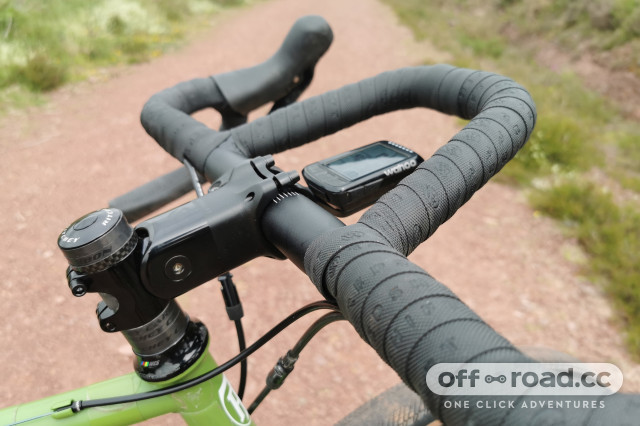The Redshift ShockStop PRO stem is an absolute revelation in terms of the performance on offer, making an instant and noticeable difference to comfort for off-road and gravel riding. Setup is simple, and it needs no further adjustment. However, it is much more expensive than the standard version for the sake of a few titanium bolts.
- Buyer's guide to gravel & adventure bikes - everything you need to know before you buy
- Redshift ShockStop Suspension Seatpost review
- Lauf True Grit Race Edition review
Redshift ShockStop PRO Suspension Stem – Technical details
The ShockStop PRO stem is available in lengths from 80mm to 120mm. It features a +/- 6 degrees angle with a range of interchangeable elastomers provided. This version tested is the PRO which features titanium bolts and weight-reducing CNC machining, claiming to be 15% lighter than the standard ShockStop. Stack height is reasonable at 40mm, so it should fit most bikes even if you have a limited steerer tube above the headset. The stem offers 20mm of bump-smoothing suspension travel. Maximum rider weight is 130kg with tuning options available, and it's suitable for flat or drop handlebars, with different elastomer suggestions depending on which you use.
The version tested was the 90mm ShockStop PRO, fitted to a gravel bike using the Redshift Kitchen Sink and replacing a stem of the same length. The stem weighed 234g with elastomers fitted, which was just 1g over the claimed weight.
There are five elastomers provided, each a different firmness and are colour coded and numbered. The elastomers can be fitted either independently or in combination with another to suit a style of riding, handlebar type and rider weight. Out of the box, it is set for a stem in a +6 degree configuration and average rider weight. I chose to use the stem at -6 degrees and change the elastomers. The process is not quick, taking around 15 minutes. Still, the instructions provided make it simple, and there is also a helpful video online. After the initial setup, you shouldn't need to set it up again unless you decide to tweak the stiffness.
Redshift ShockStop PRO Suspension Stem – How it feels
On the first ride, I could immediately feel a change on surfaced roads. The first big 'wow' moment came when riding over a cattle grid that felt smoothed out substantially. Off-road, the surprises continued. The difference was dramatic when fitted and ridden forest tracks, byways, and even more adventurous excursions.
On smaller undulations, such as small holes, rougher rocks and usual track imperfections, the ride is muted, with the stem taming impacts and increasing comfort. The stem does have a limit on what it can absorb, and 20mm of travel isn't going to turn a gravel bike into a mountain bike, but the improvements and differences are apparent.
As with all forms of suspension, the rebound rate and compression can occasionally cause a slight jarring, where the rebound is not quick enough to respond. This proved only to be very occasional, on certain sharp, repeated bumps, and I found it most notable on a few braking spots, but overall, this was rare.
The performance does change a bit depending on your riding position on the bike and, in particular, the gradient. On flatter tracks, the effects and suspension were less marked, but head downhill, where your body weight is naturally more on the bars, the performance improves. I was happy with the setup, so I chose not to adjust the elastomers, but if flatter riding or a more reactive setup was preferable, swapping the elastomers would undoubtedly have benefits.
While testing, I took the bike down more challenging tracks, including some red-graded mountain bike trails. Despite the rougher ground, the performance continued to impress. There is no bottom-out clunk on bigger impacts, although I did occasionally have a top-out impact on the rebound.
The improvement was not just restricted to comfort, and I noticed control both downhill and uphill on technical sections improved, with the tyres maintaining more contact with the ground because of the suspension movement.
Suppose you climb out of the saddle, as I do, and haul on the bars. In that case, you can feel a very slight movement. However, when compared to other forks and suspension options, the difference is more minimal. After just a few rides, you will likely forget about it. If used purely on a road bike, this may be slightly different, but certainly off-road, the advantages make it easy to live with and get used to.
Redshift ShockStop PRO Suspension Stem – Verdict
While testing, I would go as far as to say that the stem has transformed the gravel bike and comfort offered when ridden on typical British terrain.
While 20mm of travel may seem limited, the effect is instant and noticeable. While there is no direct comparison with other suspension stems, other forms of suspension are aimed towards the same market.
The Lauf fork, which uses a fibreglass leaf spring design, is fitted to the Lauf True Grit bike and offers slightly more travel at 30mm, and downhill, it does feel more capable. But the most noticeable difference is the amount of lateral flex or lack of it on the Redshift ShockStop. While I really like the Lauf fork, it can flex side-to-side, especially when climbing out of the saddle. A Lauf fork costs £890, and while it is light for a suspension fork, at 850g, it's still 300-400g heavier compared to a standard carbon fork, compared to around 100g for the ShockStop.
Compared to a fully sprung suspension fork, which can be rare for a gravel bike, the differences in weight and price only increase further, with the Fox AX tested recently costing £900 and weighing in at 1,350g for its 40mm of travel.
The other main option to compare against would be an increased tyre size, which can also increase comfort when set at suitable pressures. Still, while this can be advantageous, it can also have downsides, such as slower rolling resistance in some cases and frame clearance in most gravel bikes.
Probably the keenest competition to the ShockStop Pro stem comes from the standard ShockStop, which costs £70 less and only weighs 32g more at 266g for the same length. If you're looking for weight savings, changing the steel bolts on a standard version to titanium will cost £26 for plain or £38 for anodised bolts and save 7g. This means the CNC machining saves 25g on this length stem. On longer stems, the savings are likely to increase.
The improvement in comfort and extra performance the ShockStop Pro Suspension Stem offers is something that every rider would notice and welcome for off-road riding. A relatively small difference in weight, compared to a non-suspension stem, transforms the ride, taking the edge off bigger hits and smoothing out general riding off-road. It's customisable for different rider types, weights and preferences, and there is no noticeable lateral flex. The only potential issue is the price and especially the increase over the standard Redshift ShockStop version. For me, I love the performance, and I'm sold on the overall concept, but even as a huge weight weenie, I would struggle to justify the extra cost.
You might also like:













1 comments
I have the 'pro' fitted to my gravel bike. The only reason for purchasing this over the standard version was the the standard was not available in 100 mm length, where the pro was available immediately. I had expected a bit of a 'subtle' result but on bad roads and especially cobblestones, the effect is really very pronounced, everything is smoothed out. Like lowering tire pressure substantially, but without the drawbacks. When pedalling out of the saddle there's a bit of give but it's easy to live with. I had been considering a suspension fork because I like to make longer rides of around 150-200 km and occasionally feel pins&needles in my hands but this fixes the problem at a lower weight and (much) lower price.